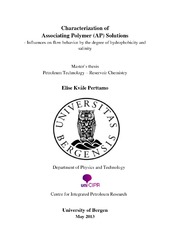| dc.description.abstract | The most applied polymer today for chemical improved oil recovery (IOR) processes, such as polymer flood and/or polymer well treatments, is the synthetic partially hydrolyzed polyacrylamide (HPAM) and its derivatives. Several field projects have been carried out utilizing HPAM, and the observed trend is that these polymers show low shear stress stability and low salt tolerance. They are also sensitive to elevated reservoir temperatures. More robust, efficient and cost- effective thickeners are needed. In this master`s thesis an characterization of modified HPAM, are carried out in low and high salinity brine at room temperature (22 ± 0.1oC). By incorporation of a relative small amount of hydrophobic groups (i.e. 8-18 carbon atoms moieties) onto the hydrophilic chain of polyacrylamide in aqueous solutions, this provides significantly changes in the behavior of HPAM. A reorientation of the macromolecules in aqueous solutions due to polar and non- polar parts, results in a formation of hydrophobic associations between the incorporated hydrophobic groups. These modified HPAM polymers are referred to as associating polymers, due to the association occurring between hydrophobic groups within a macromolecule and between hydrophobic groups at neighboring macromolecules. This characterization process involves shear viscosity measurements at different polymer concentrations and viscoelasticity measurements of entangled polymer solutions in different salinity brines. The purpose of this rheological characterization was to; detect thickening ability, shear stress stability, the strength of polymer gels and compare the elastic deformation response of gel solutions with increasing degree of hydrophobicity and increasing salinity of the brine. In this study three polymers with the same polymer base with increasing degree of hydrophobicity (FP3630S, C319, D118) were compared. In addition to an HPAM with lower molecular weight, but much higher degree of hydrophobicity, B192, was characterized. Observations from shear viscosity measurements show improved thickening ability at high concentrations with increasing degree of hydrophobicity. A relative low content of incorporated associating groups seems to improve the thickening ability of HPAM with increasing salinity of the brine. Above a given concentration, CAC (critical association concentration), the associating macromolecules start to interact and form associating network. Formation of this gel structure seems to enhance the viscosity of the solution significantly. In the untangled polymer concentration range, below C* (critical overlap concentration), the viscosity seems to be reduce with increasing degree of hydrophobicity on HPAM. Increase of salinity in the brine, it observed to reduce the viscosity even further. These observations correspond well when the dominating interactions are the intramolecular hydrophobic interactions. The yield point and gel point was measured for entangled gel solutions from viscoelastic measurements. The yield point indicates the maximum shear stress applied on the gel solution before it starts to deform, and after this threshold value the deformation response due to increasing shear stress was detected. The strength of the gel structure is observed to increase with increasing amount of associating groups, due to reinforcement of the intermolecular hydrophobic. Salinity effect seems to reduce interactions in the gel network. For B192, the strength of gel structure is observed to be stronger than HPAM based polymers in low salinity brine, but the gel structure seems to be easier deformed. This may indicate that B192 has a different gel structure than HPAM based polymers, due to lower molecular weight. Increasing salinity of the brine seems to increase the strength of the interactions in the gel structure of B192, due to the high amount of associating groups and low degree of hydrolysis. The gel point indicates the strength of the gel structure during a transition from viscoelastic liquid to viscoelastic solid or vice versa. The discussion about gel strength is the same as for yield point. | en_US |
